Ionization smoke detector
Ionization (ionisation) smoke detector is a well established technology. Principle of its operation and construction are covered at length in numerous publications, to name a few:
https://www.ti.com/lit/an/snoa960/snoa960.pdf ;
https://circuitcellar.com/wp-content/uploads/2012/06/CC2011110601.pdf ;
http://robruark.com/other/Radiation/smoke_detector/smoke.html .
In essence, an ionization-type smoke detector includes an ionization chamber with two electrodes with electric field between them, and a radioactive source for causing ionisation within the chamber. Radiation produces ions, and the electric field creates an ion current flow between the electrodes. As combustion products enter the chamber, the ions attach themselves to the particles of these products, and due to reduced mobility of the particles, the magnitude of the ion current is accordingly reduced. This reduction of the current is sensed in one way or another by an electronic circuit, and once a certain threshold is reached, a smoke alarm triggers.
Typically a radioactive alpha-source Americium-241 is used in ionisation smoke detectors. Though activity of the source is low, alpha particles have short propagation range and are easily blocked by even a very thin shield, still designers and users are uneasy about using radioactive materials in the device. Besides, ion current is typically very small, in the picoampere region, so even minor parasitic leakage currents caused by humidity or dust, can not be tolerated.
Alternative ionisation methods
Apart from a alpha radioactive source, other methods of prodicing charged particles (electrons and ions) are possible. However they have certain drawbacks.
1. Thermionic emission
A hot filament can emit free electrons, but tungsten filament would burn in the air. A platinum wire will not burn, but its electronic emission is very low due to high work out (5.7eV). Platinum atoms do not part with electrons easy. Low work function materials like Cesium or Barium would instantly oxidise, and an oxide cathode, BaO, as commonly used in electron valves, wouldbe quickly "poisoned" by varios chemical contaminants in the air.
2. Ultra violet light
Such would require very short wave length ultra-violet (UV) radiation, probably about 100um, while commercilal light emitting diodes produce UV of 365...400um, some special UV-C LEDs go down to 275um, whichis still not sufficient. Mercury arc lamps produce 254um UV, but impractical due to size and power consumption.
3. X-rays
Generating hard X-rays with photon energy of 30...100keV from a radioactive source would be more harmful than alpha radiation. Using some kind of X-ray tubes in pulsed mode is obviously impractical due to size, high voltages and power consumption.
4. Arc / spark discharge
It is not suitable as it creates heavily ionised plasma rather than just generating free charged particles.
5. Corona discharge
Though it requires high voltage and known to produce ozone, corona discharge generates free charge carriers and at the same time creates electric field getting this charges to drift. Combination of these effects makes corona discharge a viable candidate for smoke detection.
Ionisation by corona discharge
Corona discharge processis illustrated by Fig.1.
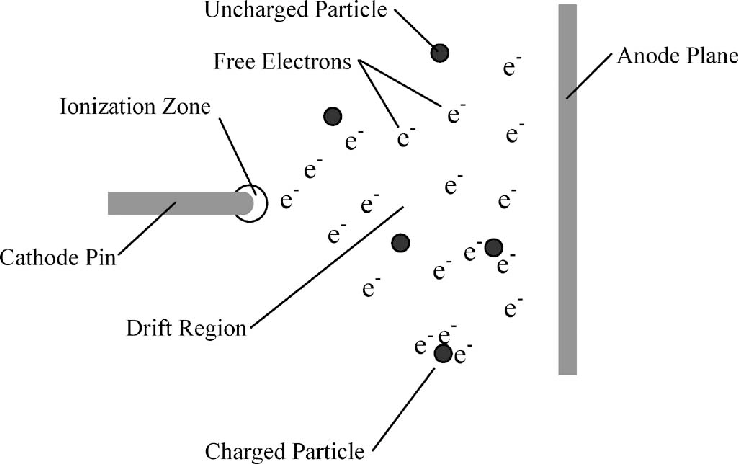
Fig. 1. Negative corona discharge.
Negative corona is commonly used for ionisation purposes. Cathode is a sharp pin powered from by 1...5kV negative voltage supply. Anode is a flat electrode, normally earthed. Strong electric field at the tip of the cathode repulses electrons with such velocity that they are able to knock secondary electrons from the air molecules. Positive ions are immediately attracted back to the cathode, knocking more electrons, while the electrons and negative ions travel away from the cathode. Further from the cathode the electric field weakens, so the electrons can no longer ionise atoms, but they can attach themselves to atoms, molecules, combustion products particles, aerosol droplets or dust. All these travelling charged particles drag neutral air with them creating so called "ionic wind" in the drift area, which consists of negatively charged particles of various kinds and sizes.
Similar to a radiation ionisation detector, smoke most likely somehow affects magnitude of current of corona discharge. A major problem however is that a reference (baseline with no smoke) current value is not stable. It varies with barometric pressure, air "breeze", humidity, temperature, erosion and corrosion of the cathode needle subject to constant ion bombardment and ozone oxidation. Therefore calibration and detection of smoke related variations is virtually impossible.
Corona triode
Using a corona triode (Fig. 2) instead of a "diode" makes a marked improvement in stability of measurements.
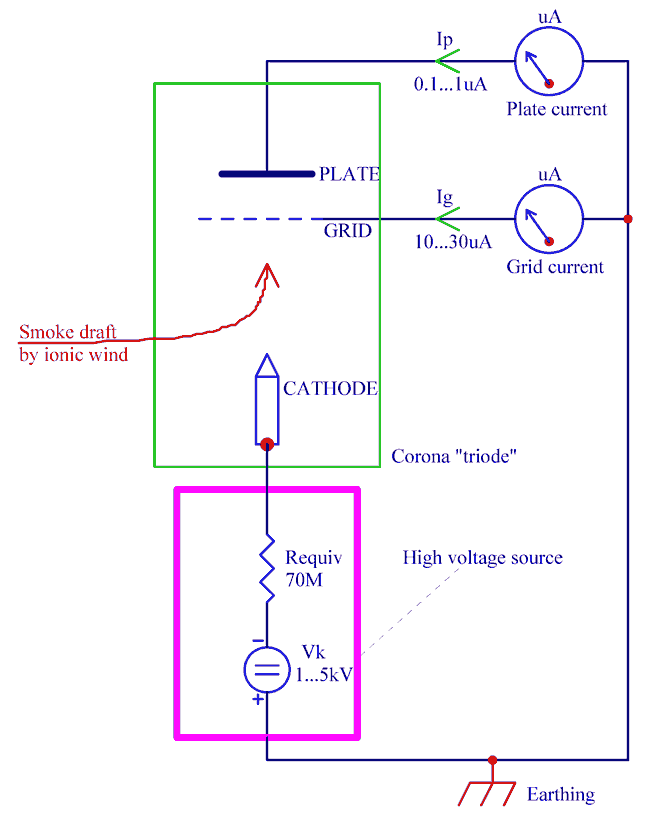
Fig. 2. Corona discharge triode construction.
Similar to a vacuum tube triode, a grid inserted between the cathode and the plate. The grid in this case is a fine metal mesh with an aperture of about 0.5...1.5mm, similar to a mosquito net or a coffee plunger filter mesh. It may be noted, that corona triodes are known and used for controlled surface charging of dielectric films, but this application as a smoke detector application is unique.
Corona discharge is sustained by a high voltage source. A simple inexpensive DC/DC converter for an "air ionizer", readily available on the open market (Fig. 3) was used in the experiments. This source has a large internal (series) resistance, of the order of 50...100MOhm, which is not an actual resistor but rather "weakness" of the DC/DC converter due to small capacitor values in its diode voltage rectifier/multiplier and low switching frequency. Large series current limiting resistance is important for safety and a stable corona discharge, as it would prevent corona discharge turning into a spark or an arc if the electrodes are brought close to each other or shorted.
With both plate and grid earthed, discharge current is split between them. Most of the current is intercepted by the grid, but some of the charged particles, carried by the ionic wind, pass through the mesh and terminate on the plate. Interestingly that plate current is much smaller (10...30 times smaller) than grid current. However, ratio of plate and grid currents Ip/Ig is quite stable. Fluctuations of these currents are proportional and correlated with the variations of cathode emission.
Remarkably, Ip/Ig ratio changes when smoke or combustion products or aerosols are present. Combustion products cause plate current Ip to reduce and grid current Ig to slightly increase. It appears as if the grid somehow intercepts large charged particles more redily than just ionised air ions or electrons in the "wind". Thus the corona triode (Fig. 2) can function as a smoke detector with Ip/Ig value being a smoke "gauge". Its sensitivity to different kinds of combustion products may be different though. That has not been investigated in detail.
Initial experiments showed that ensitivity to smoke improves as the cathode-to-grid distance increases. On the other hand, the distance shall not be too large to prevent the "wind" spreading in all directions, charging surrounding objects and wasting discharge current. Distance from cathode to grid should be several times larger than aperture of the grid mesh, and, in turn, overall size of the grid should be several times larger than the cathode-to-grid distance.
Practically, cathode-to-grid distance of 6...10mm is quite reasonable. Plate-to-grid gap does not seem to have much effect on the sensitivity, and can be about 1...3mm. A larger distance will result in a lower plate current, which would be more difficult to measure.
Photos Fig. 3 and Fig. 4 show the prototype of the corona triode used in the experiments.
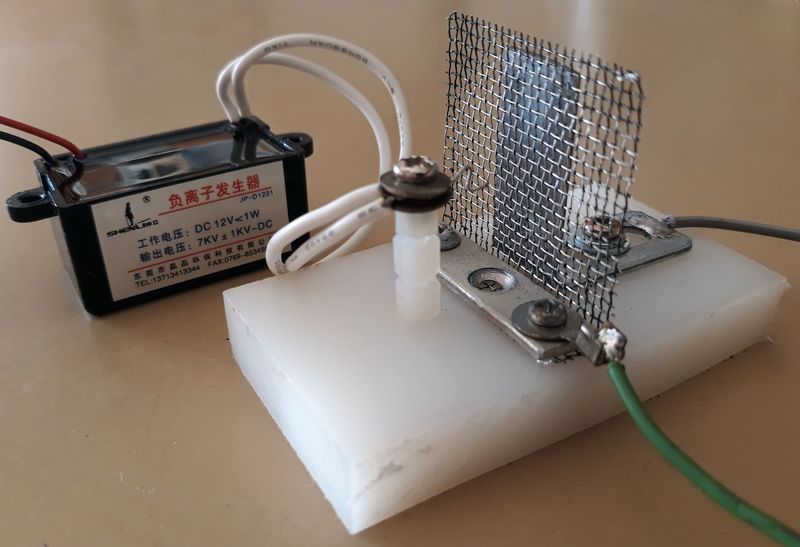
Fig. 3. Corona "smoke triode" - smoke detector with DC/DC converter.
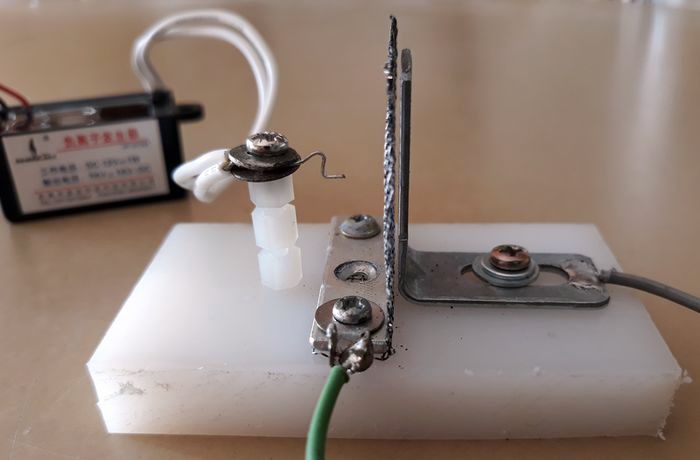
Fig.4. Corona "smoke triode", side view.
The prototype is assembled on a teflon base for low leakage. Aluminium mosquite mesh is used as grid. A steel bracket placed 1.5mm behind the grid serves as plate. An inexpensive and readily available 12V-to-6kV DC/DC converter for a DYU air ioniser/purifier is used as high voltage source. Note that its black wire is common as negative terminal of input 12V supply, as well as positive high voltage output. This node must be earthed and shall not be left floating or galvanically isolated, otherwise the whole circuit will get positively charged with respect to earth, which in turn will affect the operation of the "smoke triode" and may cause breakdown of some insulation or even an electric "jolt" on touch. Positive charging occurs because some portion of the charge carrying ionic wind misses the grid and dissipates in the environment. In other words, cathode current is always slightly larger than a sum of grid and plate currents.
For that reason, it is not desirable to use large plastic parts, components or enclosure for a corona smoke triode. Plastic parts would collect negative surface charge and will start slowing or deflecting the "wind" and affecting Ig and Ip currents. Since surface static charge accumulation depends on humidity, this phenomenon will add to instability. Even the teflon base of the prototype (Fig. 3, 4) is not ideal. The best would be to have a large conductive (metal od conductive plastic) earthed enclosure in a form of a a mesh or a can with adequate openings for intake and exhaust of the ionic wind and only use small insulators to support the electrodes of the corona triode. Needless to say, the size of this enclosure should be large enough -- distance from the cathode to the enclosure shall be several times larger that cathode-to-grid distance. Otherwise the corona discharge will be attracted to the enclosure in all directions, rather than heading toward the grid.
Biased corona triode smoke detector
Experiment showed that sensitivity of a corona triode as a smoke detector can be improved by creating a reverse bias between the grid and the plate (Fig. 5).
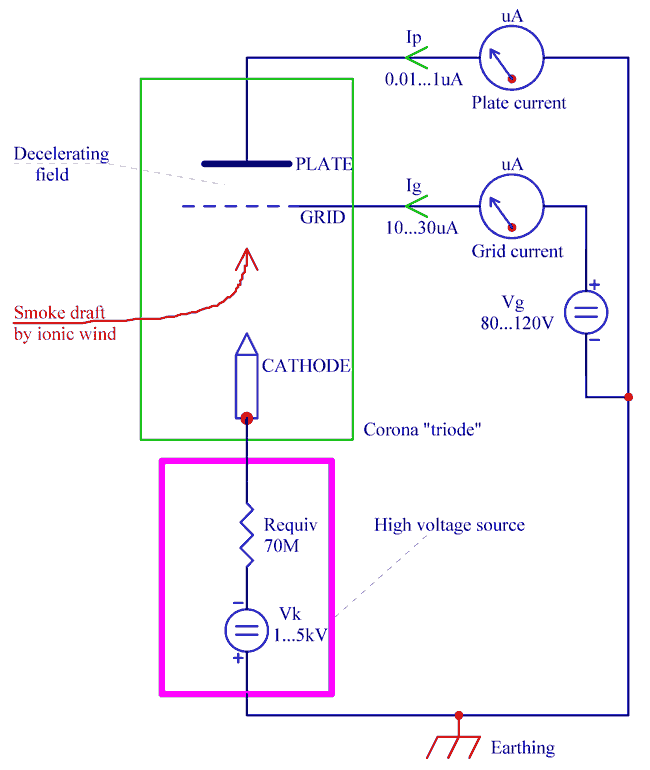
Fig. 5. Biased corona triode as smoke detector.
By applying negative voltage to plate with respect to grid, or positive voltage to grid with respect to plate, as illustrated by Fig.5, reverse bias is created between grid and plate. It creates an electric field, decelerating negatively charged particles comprising the ionic wind.
The higher the bias, the lower the plate current. With the bias strong enough, charged particles will not have sufficient momentum to reach the plate at all. For example, in the above prototype, plate current would cut off at about Vg = 120V, but obviously the cut-off point depends on the geometry of the electrodes and the cathode potential. For example, the finer the grid mesh, the lower the cut-off voltage.
The most efficient smoke detection can be achieved if the bias is set close to cut-off. For example, with Ig = 5...10uA, the bias should be set so that Ip = 10...50nA. (In this prototype it happens at Vg = 70...100V). Smoke causes an appreciable change in Ip and hence in Ip/Ig ratio.
Direction of Ip/Ig change depends on the type of combustion products. It was noticed that clear smokeless flame causes Ig to raise and Ip to reduce, while visible smoke causes Ip to increase. These changes also depend on the chemical composition of the smoke. There is also some "memory effect" -- after the visible smoke is removed, Ip comes back to the quiescent (baseline) value rather slow, within a minute. In comparison, removal of a clear flame source brings Ip to its original value quickly. Such difference in behaviour may be attributed to smoke particles contaminatiing the corona triode electrodes. The author of this article is not able to explain these phenomena with certainty, but here is a hypothesis.
If smoke, particularly consisting of relatively large combustion particles, enters close to the cathode, where the electric field and negative potential is high, then these large and heavy particles get impregnated with large number of electrons, in other words, acquire a substantial negative charge. When these particles enter the decelerating field zone, they experience relatively large electrostatic stopping force. The stopping force exceeds the "push" of the "wind", thus the particles can not reach the plate, and the plate current drops.
If, on the other hand, smoke or aerosol particles are small and light, only a few electrons would stick to them, yet more than one per particle. As a result, the stopping force is small compared to the "push" of the "wind", and the particles sail past the grid to the plate much easier than just single electrons or ionised air molecules. Hence, the plate current increases.
In some cases smoke was causing wild fluctuations of Ip/Ig. It may be explained by non-uniform concentration of smoke particles passing through the corona triode. Smoke "puffs" carried through the corona triode by the ionic wind would at first cause a disturbance in Ig, and then, after some smoke propagation time T, would affect Ip. The lag "T" may be determined by experiments, analysing cross-correlation between Ip(t) and Ig(t). Once the correlation lag T is determined, it would be reasonable to use Ip(t+T)/Ig(t) for smoke detection, rather than simply Ip(t)/Ig(t).
Further development
Different types of combustion may cause different response in the corona triode. It might be even possible to determine a type of smoke by the behavious of the corona triode.
Further experiments and modifications may include insertion of additional grids, thus creating a "tetrode". "pentode". etc. The grids may have different potintials and/or apertures.
Some of the grids may be floating, their potential measured by a high input impedance buffer amplifier, like in a common radioactive ionisation detector.
Several plates at different voltages may be tried in attempt to obtain more smoke type dependent parametres. If their respective currents are not be fully correlated, then a neural network algorithm might be able to distinguish between different types of smoke.
Magnetic field might be helpful. Generally, magnetic field would be reducing the current by deflecting the charged "wind" off the straight path. Depending on charge-to-mass ratio of the smoke particles, magnitude of such deflection and hence current change will be different for different type of smoke. For example, two plates can be used: one as a reference, the other -- between the poles of a magnet.
It is worth noting that the ionic wind can work as a pump or injector drawing smoke into the detector. In a way, a corona triode with appropriately located intake and exhaust ducts becomes an aspirating smoke detector.
Anticipated drawbacks of corona triode
Such issues as need for high voltages, good insulation, large clearances around the corona discharge area and path of the wind, as well as ozone generation and corrosion have already been mentioned. One can expect that, over time, the grid will get clogged by dust, as dust particles also get negatively charged and cling to the grid and plate.
